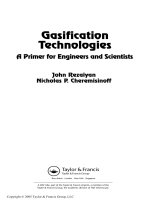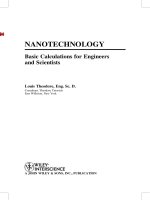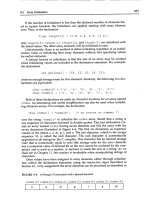gasification technologies a primer for engineers and scientists
Bạn đang xem bản rút gọn của tài liệu. Xem và tải ngay bản đầy đủ của tài liệu tại đây (10.67 MB, 338 trang )
Gasification
Technologies
A Primer for Engineers and Scientists
John Rezaiyan
Nicholas P. Cheremisinoff
Copyright © 2005 Taylor & Francis Group, LLC
The source for the cover picture is the U.S. Department of Energy, National Energy Technology Laboratory’s
Web site: />Published in 2005 by
CRC Press
Taylor & Francis Group
6000 Broken Sound Parkway NW, Suite 300
Boca Raton, FL 33487-2742
© 2005 by Taylor & Francis Group, LLC
CRC Press is an imprint of Taylor & Francis Group
No claim to original U.S. Government works
Printed in the United States of America on acid-free paper
10987654321
International Standard Book Number-10: 0-8247-2247-7 (Hardcover)
International Standard Book Number-13: 978-0-8247-2247-0 (Hardcover)
This book contains information obtained from authentic and highly regarded sources. Reprinted material is
quoted with permission, and sources are indicated. A wide variety of references are listed. Reasonable efforts
have been made to publish reliable data and information, but the author and the publisher cannot assume
responsibility for the validity of all materials or for the consequences of their use.
No part of this book may be reprinted, reproduced, transmitted, or utilized in any form by any electronic,
mechanical, or other means, now known or hereafter invented, including photocopying, microfilming, and
recording, or in any information storage or retrieval system, without written permission from the publishers.
For permission to photocopy or use material electronically from this work, please access www.copyright.com
( or contact the Copyright Clearance Center, Inc. (CCC) 222 Rosewood Drive,
Danvers, MA 01923, 978-750-8400. CCC is a not-for-profit organization that provides licenses and registration
for a variety of users. For organizations that have been granted a photocopy license by the CCC, a separate
system of payment has been arranged.
Trademark Notice:
Product or corporate names may be trademarks or registered trademarks, and are used only
for identification and explanation without intent to infringe.
Library of Congress Cataloging-in-Publication Data
Catalog record is available from the Library of Congress
Visit the Taylor & Francis Web site at
and the CRC Press Web site at
Taylor & Francis Group
is the Academic Division of T&F Informa plc.
Dk3024_Discl Page 1 Monday, March 7, 2005 10:40 AM
Copyright © 2005 Taylor & Francis Group, LLC
Table of Contents
Chapter 1
Principles of Gasification 1
Introduction 1
Historical Perspective and Commercialization Trends 2
Historical Perspectives 2
Renewed Interest and the Incentives for Commercialization 3
Commercialization Growth and Today’s Applications 4
Gasification Principles 5
Overview 5
Hydrogenation 7
Stoichiometric Considerations 7
Gasification Versus Combustion 10
Comparisons of General Features 10
Environmental Controls 10
Solid Byproducts 13
Advantages of Gasification over Combustion 14
Stoichiometries and Thermodynamics 16
Drying 17
Devolatilization 17
Gasification 17
Combustion 18
DK3024_C000.fm Page xiii Friday, March 4, 2005 3:58 PM
Copyright © 2005 Taylor & Francis Group, LLC
xiv Rezaiyan and Cheremisinoff
Gasification Kinetics 20
Biomass Gasification 23
Overview 23
Types of Biomass Gasifiers 24
Biomass Characteristics 25
Petroleum Coke Gasification 27
References 30
Recommended Resources 32
Chapter 2
Coal Gasification Technologies 35
Introduction 35
Coal Gasification 36
Overview 36
Types of Coal 36
Composition and Structure 38
Characteristics 39
Gasifier Configurations 40
Gasifier Classification 40
Entrained Flow Technologies 41
Fluidized-bed Technologies 54
Moving-bed Technologies 62
Technology Suppliers 64
Syngas Characteristics 64
Gas Cleanup Systems 65
Technology Suppliers for Particulate Removal 67
Sulfur Removal 67
The Power Block 68
Comparisons Between Technologies 68
Syngas Applications and Technology Selection Criteria 68
Integrated Gasification Combined Cycle 81
Operational Feedback 85
Investment Costs 86
Guide to Commercial Experience 86
Chapter 3
Biogasification 119
Introduction 119
Overview 119
Technology Advantages 120
General Applications 121
Commercial Systems 121
DK3024_C000.fm Page xiv Friday, March 4, 2005 3:58 PM
Copyright © 2005 Taylor & Francis Group, LLC
Table of Contents xv
Contaminants 127
Formation of Tars 130
Ammonia Formation 131
No
X
Formation 132
Sulfur 132
Hydrogen Production from Biomass 133
Recommended Resources 140
EndNotes 143
Chapter 4
Pyrolysis 145
Introduction 145
Pyrolysis Principles 147
General 147
Effect of Heating Rate 149
Effect of Temperature 150
Applications 152
Large-scale Commercial Processes for Mixed Solid Waste 152
Application to Contaminated Soil Remediation 157
Treatment of Municipal Solid Waste 158
Treatment of Medical Waste 159
Plasma Torches and Plasma Pyrolysis 160
EndNotes 164
Chapter 5
Gas Cleanup Technologies 165
Introduction 165
Overview of Particulate Removal Technologies 165
Particulate Collection Technologies 170
Gravity Settling Chambers 170
Cyclone Separators 177
Fabric Filter Pulse Jet-Cleaned Type 185
Dry Electrostatic Precipitator: Wire-Pipe Type 193
Wet Electrostatic Precipitator: Wire-Pipe Type and
Others 200
Venturi Scrubbers 208
Orifice Scrubber 214
Condensation Scrubbers 219
Gas Conditioning Technologies 221
Packed Tower and Absorption 222
Impingement-Plate/Tray Tower Scrubbers 231
Fiber-Bed Scrubbers 236
DK3024_C000.fm Page xv Friday, March 4, 2005 3:58 PM
Copyright © 2005 Taylor & Francis Group, LLC
xvi Rezaiyan and Cheremisinoff
Activated Carbon and Other Adsorber Systems 239
Thermal Destructive Technologies 247
Recommended Resources 265
Chapter 6
Integration of Gasification Technologies 271
Introduction 271
Role of Coal Gasification 271
Gas Turbine Technologies 282
Fuel Requirements 286
Use of Coal-Derived Liquid Fuel 287
Market Trends 289
R&D Needs 294
Improved Operational Performance 294
Improved Efficiencies 294
Fuel Cell Technology Development Status 298
Integrated Gasification Fuel Cell Power
Systems Requirements 305
Integrated Gasification Fuel Cell Hybrid Power Systems
Requirements 307
System Configurations and Costs 309
Fuel Processing Technology 313
Technology Integration with Coal Gasification 313
Hybrid Systems 315
Fuel Cell Technology and System Integration Issues 317
Areas for Technical Development 318
Large-Scale Distributed Power, Industrial Cogeneration, and
Central Generation 319
Gasification Technology Development and System Integration
Issues 320
Recommended Resources 328
DK3024_C000.fm Page xvi Friday, March 4, 2005 3:58 PM
Copyright © 2005 Taylor & Francis Group, LLC
xvii
Preface
Gasification technologies offer the potential of clean and efficient
energy. The technologies enable the production of synthetic gas from
low or negative-value carbon-based feedstocks such as coal, petro-
leum coke, high sulfur fuel oil, materials that would otherwise be
disposed as waste, and biomass. The gas can be used in place of
natural gas to generate electricity, or as a basic raw material to
produce chemicals and liquid fuels.
Gasification is a process that uses heat, pressure, and steam to
convert materials directly into a gas composed primarily of carbon
monoxide and hydrogen. Gasification technologies differ in many
aspects but rely on four key engineering factors:
1. Gasification reactor atmosphere (level of oxygen or air
content)
2. Reactor design
3. Internal and external heating
4. Operating temperature
The feedstock is prepared and fed, in either dry or slurried form,
into a reactor chamber called a gasifier. The feedstock is subjected
DK3024_C000.fm Page xvii Friday, March 4, 2005 3:58 PM
Copyright © 2005 Taylor & Francis Group, LLC
xviii Rezaiyan and Cheremisinoff
to heat, pressure, and either an oxygen-rich or oxygen-starved envi-
ronment within the gasifier. All commercial gasifiers require an
energy source to generate heat and begin processing.
There are three primary products from gasification:
• Hydrocarbon gases (also called syngas)
• Hydrocarbon liquids (oils)
• Char (carbon black and ash)
Syngas can be used as a fuel to generate electricity or steam, or
as a basic building block for a multitude of chemicals. When mixed
with air, syngas can be used in gasoline or diesel engines with few
modifications to the engine.
Both pyrolysis and gasification convert carbonaceous materials
into energy-rich fuels by heating the feedstock under controlled
conditions. Whereas incineration fully converts the input material
into energy and ash, these processes deliberately limit the conver-
sion so that combustion does not take place directly. Instead, they
convert the material into valuable intermediates that can be further
processed for materials recycling or energy recovery.
Gasification in particular offers more scope for recovering prod-
ucts from waste than incineration. When waste is burned in a modern
incinerator the only practical product is energy, whereas the gases,
oils, and solid char from gasification can not only be used as a fuel
but also be purified and used as a feedstock for petro-chemicals and
other applications. Gasification can be used in conjunction with gas
engines and gas turbines to obtain higher conversion efficiency than
conventional fossil-fuel electric power generation. In contrast, con-
ventional incineration, used in conjunction with steam-cycle boilers
and turbine generators, achieves lower efficiency. Gasification can help
meet renewable energy steam targets, address concerns about global
warming, and contribute to achieving Kyoto Protocol commitments.
There are more than 150 companies around the world that are
marketing systems based on gasification concepts. Many of these
are optimized for specific wastes or particular scales of dedicated
energy production operations. They vary widely in the extent to
which they are proven in operation. In addition, there are more than
100 facilities operating around the world.
This book serves as a primer to coal and biomass gasification
technologies. It is meant as an introduction and overview of current
technology developments, and to provide readers with a general
DK3024_C000.fm Page xviii Friday, March 4, 2005 3:58 PM
Copyright © 2005 Taylor & Francis Group, LLC
Preface xix
understanding of the technology challenges for large-scale commer-
cialization. While there is an abundant source of literature both on
the World Wide Web and in printed form, the information and
experiences in development and commercialization are fragmented.
This volume helps to place the technology and research and devel-
opment challenges into perspective.
Nicholas P. Cheremisinoff, Ph.D.
A. John Rezaiyan
Princeton Energy Resources International, LLC
DK3024_C000.fm Page xix Friday, March 4, 2005 3:58 PM
Copyright © 2005 Taylor & Francis Group, LLC
xxi
About The Authors
Nicholas P. Cheremisinoff
has 30 years of industry and applied
research and development experience throughout the petrochemical
and allied industries. His assignments have focused on implemen-
tation of clean technologies for manufacturing and energy production,
with experiences ranging from fossil energy to biomass and wind
energy applications. He has worked extensively on overseas assign-
ments for donor agencies such as the United States Agency for
International Development, for international lending institutions
including the World Bank Organization, and for numerous private
sector clients. He is the author, co-author, or editor of more than
100 technical books. Dr. Cheremisinoff received his B.Sc., M.Sc., and
Ph.D. degrees in chemical engineering from Clarkson College of
Technology.
A. John Rezaiyan
is Vice President for Advanced Engineering
Group at Princeton Energy Resources International LLC (PERI).
He has 25 years of experience in fluidized-bed combustion and
gasification technology development. He works closely with technology
developers, project developers, government agencies, and financial
institutions to assess market potential and technical, economic, and
DK3024_C000.fm Page xxi Tuesday, March 8, 2005 3:15 PM
Copyright © 2005 Taylor & Francis Group, LLC
xxii Rezaiyan and Cheremisinoff
commercial viability of advanced power generation, coke making,
and still making technologies. More recently, Mr. Rezaiyan has
focused his effort in helping clients to commercialize their technology.
He is the author of a number of articles addressing the market
potential of and financing strategies for advanced clean coal tech-
nologies. Mr. Rezaiyan received his B.S. degree in chemical engi-
neering from University of Maryland at College Park.
DK3024_C000.fm Page xxii Tuesday, March 8, 2005 3:15 PM
Copyright © 2005 Taylor & Francis Group, LLC
1
1
Principles of Gasification
INTRODUCTION
Gasification technologies have been commercially applied for
more than a century for the production of both fuels and
chemicals. Current trends in the power generation and refin-
ery industries support the observation that advanced stages
of the technology will continue to be applied toward the syn-
thesis of syngas, with an increasing number of applications
in power generation, fuels, and basic chemicals manufacturing.
Attractive features of technology include:
• The ability to produce a consistent product that can
be used for the generation of electricity or as primary
building blocks for manufacturers of chemicals and
transportation fuels.
• The ability to process a wide range of feedstocks includ-
ing coal, heavy oils, petroleum coke, heavy refinery
residuals, refinery wastes, hydrocarbon contaminated
soils, biomass, and agricultural wastes.
• The ability to remove contaminants in the feedstock
and to produce a clean syngas product.
• The ability to convert wastes or low-value products to
higher value products.
DK3024_book.fmPage1Thursday,January20,20053:42PM
Copyright © 2005 Taylor & Francis Group, LLC
2Rezaiyan and Cheremisinoff
• The ability to minimize the amount of solid waste
requiring landfill disposal. Solid by-products have a
market value can be used as fuel or construction mate-
rial, and are non-hazardous.
This chapter provides an overview of the technology, the
products that can be made using this technology, important
terminology, and a general overview of the history and modern
development trends.
HISTORICAL PERSPECTIVE AND
COMMERCIALIZATION TRENDS
Historical Perspectives
The earliest practical production of synthetic gas (syngas) is
reported to have taken place in 1792 when Murdoch, a Scot-
tish engineer, pyrolyzed coal in an iron retort and then used
the product, coal gas, to light his home.
1
Later on, Murdoch built a gas plant for James Watt, the
inventor of the steam engine, and applied the technology to
lighting one of Watt’s foundries.
The first gas company was established in 1812 in London
to produce gas from coal and to light the Westminster Bridge.
In 1816, the first gas plant for the manufacture of syngas
from coal was built in the United States to light the streets
of the city of Baltimore. By 1826, gas plants were also built
to manufacture gas for lighting the streets of Boston and New
York City. Soon thereafter, gas plants and distribution net-
works were built to light the streets of most major cities
throughout the world.
In 1855, the invention of the Bunsen burner premixed
air and gas, allowing it to burn more economically, at very
high temperatures, and without smoke. This invention added
impetus to the further use of gas.
1
Lowry, H. H., editor,
Chemistry of Coal Utilization,
John Wiley & Sons,
1945, p. 1252.
DK3024_book.fmPage2Thursday,January20,20053:42PM
Copyright © 2005 Taylor & Francis Group, LLC
Principles of Gasification 3
In the latter half of the 19
th
century coal gasification
became a commercial reality through the use of cyclic gas
generators,
2
also know as air-blown gasifiers. By 1875, man-
ufactured gas was being widely used for home lighting, and
by the end of the century it was applied to domestic and
industrial applications. In the United States more than 1200
gas plants were in operation by the late 1920s.
In early 1900s, biomass gasification processes were also
widely used to manufacture synthetic gases for production of
fuels, chemicals, and hydrogen. During World War II, over
1 million air-blown gasifiers were built to produce synthetic
gas from wood and charcoal to power vehicles and to generate
steam and electricity.
3
After World War II, the discovery of large quantities of
low-cost natural gas with heating values of about 37 MJ/m
3
(1000 Btu/ft
3
) led to the demise of the synthetic gas manufac-
turing industry.
Renewed Interest and the Incentives
for Commercialization
Interest in gasification technologies was renewed throughout
the 1960s and 1970s when controversial projections suggested
that natural gas reserves would be depleted and demand
would exceed reserves by the 1980s and 1990s. Also the oil
embargo of 1973 created awareness for the need to identify
alternative sources of fuel.
Throughout the 1980s, researchers and industry came to
recognize some of the environmental benefits of gasification
technology. More restrictive and stringent environmental
standards aimed at controlling power plant emissions, and
domestic and industrial waste landfills, and an increased
2
Cyclic gas generators converted coke, a by-product of high-temperature
pyrolysis process, to a synthetic gas by alternatively exposing the coke to
air to provide heat and to steam to produce a gas that burned with a blue
flame. The coal gas was know as “blue water gas” (Probstein, R. F. and
Hicks, R. E.,
Synthetic Fuels,
McGraw-Hill, 1982, p. 7).
3
Klass, D. L.,
Biomass for Renewable Energy, Fuels, and Chemicals,
Aca-
demic Press, 1998, p. 271.
DK3024_book.fmPage3Thursday,January20,20053:42PM
Copyright © 2005 Taylor & Francis Group, LLC
4Rezaiyan and Cheremisinoff
emphasis on greenhouse gas reductions provided incentives
for both government and industry stakeholders to explore and
promote the commercialization of gasification technologies.
Commercialization Growth and Today’s Applications
Based on a survey reported for 2003, there are 163 commercial
gasification projects worldwide consisting of a total of 468
gasifiers.
4
More than 120 plants began their operations
between 1960 and 2000 with the majority (more than 72 plants)
commissioned after 1980. Up to 34 new plants are at various
stages of planning and construction.
The majority of the existing plants were designed and
constructed to produce a synthetic gas, consisting primarily
of hydrogen and carbon monoxide (CO), which is used for the
production of hydrogen or Fischer-Tropsche (F-T) syncrude.
Hydrogen is then used to produce a wide variety of chemicals
and fertilizers. The Fisher-Tropsch syncrude is used to man-
ufacture transportation fuels, lube oils, and specialty waxes.
Among the most recent plants are those designed to
produce a synthetic gas suited for firing in gas turbines for
the production of clean electric power. Major projects in the
United Sates for clean power generation have included Global
Energy’s Wabash River Power Station in Indiana and Tampa
Electric’s Polk County Power Station in Florida. These plants
began operation in 1995 and 1996, respectively. They both use
coal as their feedstock and are based upon an Integrated
Gasification Combined Cycle (IGCC) plant configuration. The
U.S. Department of Energy (DOE) and the private sector
project owners shared the cost for design, construction, and
initial operation of these plants.
Recent commercial projects use refinery waste or prod-
ucts that no longer have a positive market value, such as
petroleum coke (petcoke) or heavy oils. Many of these projects
are referred to as “trigeneration” plants because they produce
hydrogen, power, and steam for use within the refinery and
4
U.S. Department of Energy, />models.
DK3024_book.fmPage4Thursday,January20,20053:42PM
Copyright © 2005 Taylor & Francis Group, LLC
Principles of Gasification 5
for export. Gasification projects in the U.S. using petcoke or
heavy oils as feedstock include the Frontier Oil gasification
project in El Dorado, TX; Motiva gasification project in Dela-
ware City, DE; Farmland Industries gasification project in
Coffeyville, KS; and Exxon-Mobile gasification project in Bay-
town, TX.
European refinery gasification projects include the API
project in Falconara, Italy; Sarlux project in Sardinia, Italy;
ISAB project in Sicily, Italy; and Shell project in Pernis, Nether-
lands. Several plants are also reported to gasify biomass to
produce gaseous fuels or electric power.
Examples of operating plants using biomass as feed-
stocks include Rudersdorfer Zement project in Germany; Lah-
den Lämpövoima Oy project, Corenso United Oy Ltd project,
and Oy W. Schauman ab Mills project in Finland; Netherlands
Refinery Company BV project in Netherlands; BASF plc
project in United Kingdom; ASSI project and Sydkraft AB in
Sweden; and Portucel project in Portugal. These projects are
generally smaller (6 to 54 MW equivalent in size) than
projects using coal, petcoke, or heavy oil as feedstock.
GASIFICATION PRINCIPLES
Overview
Gasification is a process for converting carbonaceous materi-
als to a combustible or synthetic gas (e.g., H
2
, CO, CO
2
, CH
4
).
In general, gasification involves the reaction of carbon with
air, oxygen, steam, carbon dioxide, or a mixture of these gases
at 1,300°F or higher to produce a gaseous product that can
be used to provide electric power and heat or as a raw material
for the synthesis of chemicals, liquid fuels, or other gaseous
fuels such as hydrogen.
Once a carbonaceous solid or liquid material is converted
to a gaseous state, undesirable substances such as sulfur
compounds and ash may be removed from the gas. In contrast
to combustion processes, which work with excess air, gasifi-
cation processes operate at substoichiometric conditions with
the oxygen supply controlled (generally 35 percent of the
DK3024_book.fmPage5Thursday,January20,20053:42PM
Copyright © 2005 Taylor & Francis Group, LLC
6Rezaiyan and Cheremisinoff
amount of O
2
theoretically required for complete combustion
or less) such that both heat and a new gaseous fuel are
produced as the feed material is consumed.
Some gasification processes also use indirect heating,
avoiding combustion of the feed material in the gasification
reactor and avoiding the dilution of the product gas with
nitrogen and excess CO
2
.
Figure 1.1 shows the principal methods for gasifying a
carbonaceous material.
When a carbonaceous material is heated, either directly
or indirectly, under gasification conditions, it is first pyro-
lyzed. During pyrolysis light volatile hydrocarbons, rich in
hydrogen, are evolved and tars, phenols, and hydrocarbon
gases are released. During pyrolysis the feedstock is ther-
mally decomposed to yield solid carbon and a gas product
stream that has higher hydrogen content than the original
carbonaceous feed material.
Figure 1.1
Gasification methods.
Gasification
Steam Air
Steam
Steam
Steam
Oxygen
Heat
Hydrogen
Heat
Gasification
Gasification
Hydro-
gasification
Catalytic
Gasification
Feed
Contaminants
Contaminants
Contaminants
Contaminants
Contaminants
Purification
Purification
Purification
Purification
Purification &
Separation
Low-Btu Gas
Medium-Btu
Gas
Medium-Btu
Gas
High-Btu Gas
SNG
CO, H
2
, N
2
CO, H
2
CO, H
2
CO, H
2
, CH
4
CH
4
DK3024_book.fmPage6Thursday,January20,20053:42PM
Copyright © 2005 Taylor & Francis Group, LLC
Principles of Gasification 7
Hydrogenation
In a gasification process the feedstock is hydrogenated. This
means hydrogen is added to the system directly or indirectly
or the feedstock is pyrolyzed to remove carbon to produce a
product with a higher hydrogen-to-carbon ratio than the feed-
stock. These processes may be carried out separately or simul-
taneously. The more hydrogen that is added or the more
carbon removed, the lower the overall efficiency of the syn-
thetic gas production process. In an indirect hydrogenation
process, steam is used as a hydrogen source and hydrogen is
produced within the gasification reactor.
An indirect hydrogenation process that is still under
development is catalytic gasification. In this process, a cata-
lyst accelerates the gasification reactions, resulting in the
formation of hydrogen and CO, at relatively low temperatures.
This process also promotes catalytic formation of methane at
the same low temperature within the same reactor. Catalyst
deactivation and costs have been a major impediment to the
commercialization of this process.
In a direct hydrogenation process feedstock is exposed to
hydrogen at high pressures to produce a gas with higher
methane content than indirect hydrogenation processes.
Indirect hydrogenation processes are also known as air
or oxygen blown gasification, depending on whether air or
oxygen is used as the oxidant source. If heat is also provided
indirectly, air or oxygen is not used to combust some of the
feedstock in the gasifier. This results in an increase in the
reactor temperature to the desired gasification reaction tem-
peratures, which is a process referred to as steam reforming.
Direct hydrogenation processes are called hydro-gasification.
Stoichiometric Considerations
Depending on the gasification process, reactions that take
place in a gasifier include:
(1) C + O
2
→
CO
2
(2) C +
1
/
2
O
2
→
CO
DK3024_book.fmPage7Thursday,January20,20053:42PM
Copyright © 2005 Taylor & Francis Group, LLC
8Rezaiyan and Cheremisinoff
(3) H
2
+
1
/
2
O
2
→
H
2
O
(4) C + H
2
O
→
CO + H
2
(5) C + 2H
2
O
→
CO
2
+ 2H
2
(6) C + CO
2
→
2CO
(7) C + 2H
2
→
CH
4
(8) CO + H
2
O
→
H
2
+ CO
2
(9) CO + 3H
2
→
CH
4
+ H
2
O
(10) C + H
2
O
→
1
/
2
CH
4
+
1
/
2
CO
2
Most of the oxygen injected into a gasifier, either as pure
oxygen or air, is consumed in reactions (1) through (3) to
provide the heat necessary to dry the solid fuel, break up
chemical bonds, and raise the reactor temperature to drive
gasification reactions (4) through (9).
Reactions (4) and (5), which are known as water-gas
reactions, are the principal gasification reactions, are endot-
hermic, and favor high temperatures and low pressures.
Reaction (6), the
Boudourd reaction,
is endothermic and
is much slower than the combustion reaction (1) at the same
temperature in the absence of a catalyst.
Reaction (7), hydro-gasification, is very slow except at
high pressures.
Reaction (8), the
water-gas shift reaction
, can be impor-
tant if H
2
production is desired. Optimum yield is obtained
at low temperatures (up to 500°F) in the presence of a catalyst
and pressure has no effect on increasing hydrogen yield.
Reaction (9), the
methanation reaction,
proceeds very
slowly at low temperatures in the absence of catalysts.
Reaction (10) is relatively thermal neutral, suggesting
that gasification could proceed with little heat input but meth-
ane formation is slow relative to reactions (4) and (5) unless
catalyzed.
In addition to the gasification agent (air, oxygen, or
steam) and the gasifier operating temperature and pressure,
other factors affect the chemical composition, heating value,
DK3024_book.fmPage8Thursday,January20,20053:42PM
Copyright © 2005 Taylor & Francis Group, LLC
Principles of Gasification 9
and the end use applications of the gasifier product gas. The
following factors affect the quality of the product gas:
•Feedstock composition
•Feedstock preparation and particle size
• Reactor heating rate
• Residence time
• Plant configuration such as:
•Feed system - dry or slurry
•Feedstock-reactant flow geometry
• Mineral removal system - dry ash or slag
• Heat generation and transfer method — direct or
indirect
• Syngas cleanup system - low or high temperature
and processes used to remove sulfur, nitrogen, par-
ticulates, and other compounds that may impact the
suitability of the syngas for specific applications (i.e.,
turbine and fuel cell for electric power generation,
hydrogen production, liquid fuel production, or chem-
ical production).
Depending on the gasifier system configuration, operat-
ing conditions, and gasification agent, four types of synthetic
gas can be produced:
• Low heating-value gas (3.5 to 10 MJ/m
3
or 100 to 270
Btu/ft
3
) can be used as gas turbine fuel in an IGCC
system, as boiler fuel for steam production, and as fuel
for smelting and iron ore reduction applications. How-
ever, because of its high nitrogen content and low heat-
ing value, it is not well suited as a natural gas
replacement or for chemical synthesis.
Use of low heat-
ing-value gas for fuel cell applications also increases
gas upgrading and processing costs, including com-
pression costs if high pressure fuel cells are used.
• Medium heating-value gas (10 to 20 MJ/m
3
or 270 to
540 Btu/ft
3
) can be used as fuel gas for gas turbines in
IGCC applications, for substitute natural gas (SNG)
in combination with methanation process, for hydro-
gen production, for fuel cell feed, and for chemical and
fuel synthesis.
DK3024_book.fmPage9Thursday,January20,20053:42PM
Copyright © 2005 Taylor & Francis Group, LLC
10 Rezaiyan and Cheremisinoff
• High heating-value gas (20 to 35 MJ/m
3
or 540 to 940
Btu/ft
3
) can also be used as fuel gas for gas turbines
in IGCC applications, for SNG and hydrogen produc-
tion, for fuel cell feed, and for chemical and fuel syn-
thesis. However, it does not require as much upgrading
and methanation to produce SNG.
• SNG (over 35 MJ/m
3
or 940 Btu/ft
3
) can be easily sub-
stituted for natural gas and therefore is suitable for
hydrogen and chemical production as well as fuel cell
feed.
GASIFICATION VERSUS COMBUSTION
Comparisons of General Features
Gasification is not an incineration or combustion process.
Rather, it is a conversion process that produces more valuable
and useful products from carbonaceous material. Table 1.1
compares the general features of gasification and combustion
technologies.
Both gasification and combustion processes convert car-
bonaceous material to gases. Gasification processes operate
in the absence of oxygen or with a limited amount of oxygen,
while combustion processes operate with excess oxygen.
The objectives of combustion are to thermally destruct
the feed material and to generate heat. In contrast, the objec-
tive of gasification is to convert the feed material into more
valuable, environmentally friendly intermediate products
that can be used for a variety of purposes including chemical,
fuel, and energy production. Elements generally found in a
carbonaceous material such as C, H, N, O, S, and Cl are
converted to a syngas consisting of CO, H
2
, H
2
O, CO
2,
NH
3
,
N
2
, CH
4
, H
2
S, HCl, COS, HCN, elemental carbon, and traces
of heavier hydrocarbon gases. The products of combustion
processes are CO
2
, H
2
O, SO
2
, NO, NO
2
, and HCl.
Environmental Controls
Depending on the composition of feed material, combustion
gases are processed in a series of process units to remove
DK3024_book.fmPage10Thursday,January20,20053:42PM
Copyright © 2005 Taylor & Francis Group, LLC
Principles of Gasification 11
T
ABLE
1.1
Comparison of Gasification and Combustion
Technologies
Features Gasification Combustion
Purpose Creation of valuable,
usable products from
waste or lower value
material
Generation of heat or
destruction of waste
Process Type Thermal and chemical
conversion using no or
limited oxygen
Complete combustion
using excess oxygen
(air)
Raw Gas
Composition
(before gas
cleanup)
H
2
, CO, H
2
S, NH
3
, and
particulates
CO
2
, H
2
O, SO
2
, NO
x
, and
particulates
Gas Cleanup Syngas cleanup at
atmospheric to high
pressures depending on
the gasifier design
Treated syngas used for
chemical, fuels, or power
generation
Recovers sulfur species in
the fuel as sulfur or
sulfuric acid
Clean syngas primarily
consists of H
2
and CO.
Flue gas cleanup at
atmospheric pressure
Treated flue gas is
discharged to
atmosphere
Any sulfur in the fuel is
converted to SO
2
that
must be removed using
flue gas cleanup
systems, generating a
waste that must be
landfilled.
Clean flue gas primarily
consists of CO
2
and H
2
O
Solid
by-products/
products
Char or slag Bottom ash
Ash/char or slag
handling
Low temperature processes
produce a char that can
be sold as fuel.
High temperature
processes produce a
slag, a non-leachable,
non-hazardous material
suitable for use as
construction materials.
Bottom ash and fly ash
are collected, treated,
and disposed as
hazardous waste in
most cases.
DK3024_book.fmPage11Thursday,January20,20053:42PM
Copyright © 2005 Taylor & Francis Group, LLC
12 Rezaiyan and Cheremisinoff
particulates, heavy metals, and inorganic acid gases. These
process units may include gas cooling, followed by Venturi
scrubbers, wet electrostatic precipitators, or ionizing wet
scrubbers. Some facilities may also use packed tower absorb-
ers for acid gas removal or fabric filters for particulate
removal. Demisters are usually used to remove visual vapor
before the combustion gases are emitted to atmosphere
through a stack. When the sulfur content of the fuel is high
and a very stringent SO
2
limit must be met, flue gas desulfur-
ization processes such as sorbent injection in the combustor,
the flue gas duct, or added process units may have to be used
for sulfur removal. Sorbent addition not only adds to a com-
bustion system’s capital and operating costs but also increases
the amount of solid waste that must be landfilled if a suitable
end-use market cannot be identified for this byproduct.
Following the gasification step, the raw syngas is
quenched directly with water or cool recycled gas. Particulates
may also be removed using hot filters. Indirect cooling through
heat exchangers may follow syngas quenching before any
entrained particulates is removed. Syngas is then further
processed to remove sulfur compounds such as H
2
S, COS, and
NH
3
. Conventional treatment technologies, with sulfur
removal efficiencies of up to 99%, are utilized in the natural
gas and petroleum industries. The same conventional tech-
nologies can be used to recover sulfur as high-purity liquid
byproduct from raw syngas. When direct water quenching is
TABLE 1.1 (CONTINUED) Comparison of Gasification and
Combustion Technologies
Features Gasification Combustion
Fine particulates are
recycled to gasifier. In
some cases fine
particulates my be
processed to recover
valuable metals.
Temperature 1300°F – 2700°F 1500°F – 1800°F
Pressure Atmospheric to high Atmospheric
DK3024_book.fmPage12Thursday,January20,20053:42PM
Copyright © 2005 Taylor & Francis Group, LLC
Principles of Gasification 13
used, some particulates are captured by water and must be
filtered. The particulate scrubber water and syngas conden-
sates contain some water-soluble gases such as NH
3
, HCN,
HCl, and H
2
S. These streams are usually recycled to the
gasifier or scrubber after entrained solids are removed. A
small portion of the water is purged from the system to pre-
vent accumulation of dissolved salts. The purged water is then
processed in a conventional wastewater treatment system.
Solid Byproducts
Solid by-products of gasification and combustion processes are
significantly different. The primary solid by-product of a low-
temperature gasification process is char. Char consists of unre-
acted carbon and the mineral matter present in the gasifier
feed. The most important and significant use of char is as a
source of activated carbon.
Char from a variety of sources, including coal, is used to
produce activated carbon. The two most important uses for
activated carbon are for water and wastewater treatment and
decolorization. Other uses for activated carbon include the
capture of pollutants such as volatile organic compounds
(VOCs) and pesticide residues from industrial waste streams.
Other markets for char include iron, steel, and sili-
con/ferro-silicon industries. Char can be used as a reducing
agent in direct reduction of iron. Ferro-silicon and metallur-
gical-grade silicon metal are produced carbothermally in elec-
tric furnaces. Silica is mixed with coke, either iron ore or scrap
steel (in the case of ferro-silicon), and sawdust or charcoal in
order to form a charge. The charge is then processed by the
furnace to create the desired product. Char can be substituted
for the coke as a source of reducing carbon for this process.
Some plants in Norway are known to have used coal-char in
the production of silicon-based metal products as late as mid-
1990.
5
The use of char in this industry is not practiced due
to lack of char supply.
5
Rezaiyan, J., private communications with producers, 1997.
DK3024_book.fmPage13Thursday,January20,20053:42PM
Copyright © 2005 Taylor & Francis Group, LLC
14 Rezaiyan and Cheremisinoff
A solid byproduct of the high-temperature gasification
process is slag, a glass-like material. It mainly consists of the
inorganic materials in the gasifier feed that are not vaporized.
Because of the gasifier’s high temperature, above the fusion
or melting temperature of the mineral matter, the mineral
matter melts and is removed as molten slag, which forms a
glassy substance upon quenching or cooling. The slag is usu-
ally found to be non-hazardous and can be used as an admix
for road construction material or abrasive material for sand
blasting. It can also be disposed of as non-hazardous waste.
Depending on its composition it could also be sold for recovery
of valuable metals.
The primary solid byproduct of combustion processes is
bottom ash, which primarily consists of mineral matter and
minor amounts of unreacted carbon. Because the leaching
property of the ash, the bottom ash from combustion of most
material is considered hazardous. An exception is the bottom
ash from combustion of biomass.
Advantages of Gasification over Combustion
From an environmental standpoint, gasification offers several
advantages over the combustion of solids, heavy oils, and
carbonaceous industrial and domestic wastes. First, emission
of sulfur and nitrogen oxides, precursors to acid rain, as well
as particulates from gasification are reduced significantly due
to the cleanup of syngas. Sulfur in the gasifier feed is con-
verted to H
2
S, and nitrogen in the feed is converted to diatomic
nitrogen (N
2
) and NH
3.
Both H
2
S and NH
3
are removed in
downstream processes, producing a clean syngas. Therefore,
if the resulting clean syngas is combusted in a gas turbine to
generate electricity or in a boiler to produce steam or hot
water, the production of sulfur and nitrogen oxides are
reduced significantly. If the clean syngas is used as an inter-
mediate product for manufacture of chemicals, these acid-rain
precursors are not formed.
The particulates in the raw syngas is also significantly
reduced due to multiple gas cleanup systems used to meet
gas turbine manufacturers’ specifications. Particulate removal
DK3024_book.fmPage14Thursday,January20,20053:42PM
Copyright © 2005 Taylor & Francis Group, LLC









